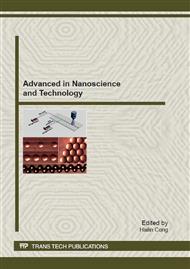[1]
Y. Hemar, et al., "Encapsulation of Resveratrol Using Water-in-Oil-in-Water Double Emulsions," Food Biophysics, vol. 5, pp.120-127, 2010.
DOI: 10.1007/s11483-010-9152-5
Google Scholar
[2]
T. Nisisako, "Microstructured devices for preparing controlled multiple emulsions," Chemical Engineering & Technology, vol. 31, pp.1091-1098, 2008.
DOI: 10.1002/ceat.200800119
Google Scholar
[3]
S. H. Han, et al., "Production of w/o/w-type multiple emulsions containing stabilized l-ascorbic acid and cosmetic composition containing the same," KR2003097504-A; KR488798-B, 2004.
Google Scholar
[4]
M. Gallarate, et al., "On the stability of ascorbic acid in emulsified systems for topical and cosmetic use," International Journal of Pharmaceutics, vol. 188, pp.233-241, Oct 1999.
DOI: 10.1016/s0378-5173(99)00228-8
Google Scholar
[5]
P. G. Humbert, et al., "Topical ascorbic acid on photoaged skin. Clinical, topographical and ultrastructural evaluation: double-blind study vs. placebo," Experimental Dermatology, vol. 12, pp.237-244, Jun 2003.
DOI: 10.1034/j.1600-0625.2003.00008.x
Google Scholar
[6]
K. Kameyama, et al., "Inhibitory effect of magnesium L-ascorbyl-2-phosphate (VC-PMG) on melanogenesis in vitro and in vivo," Journal of the American Academy of Dermatology, vol. 34, pp.29-33, Jan 1996.
DOI: 10.1016/s0190-9622(96)90830-0
Google Scholar
[7]
N. Pakpayat, et al., "Formulation of ascorbic acid microemulsions with alkyl polyglycosides," European Journal of Pharmaceutics and Biopharmaceutics, vol. 72, pp.444-452, Jun 2009.
DOI: 10.1016/j.ejpb.2009.01.005
Google Scholar
[8]
M. Rinaudo, "Main properties and current applications of some polysaccharides as biomaterials," Polymer International, vol. 57, pp.397-430, 2008.
DOI: 10.1002/pi.2378
Google Scholar
[9]
M. Drach, et al., "Antioxidative properties of vitamins C and E in micellar systems and in microemulsions," 2011.
Google Scholar
[10]
N. Garti, "Double emulsions - Scope, limitations and new achievements," Colloids and Surfaces a-Physicochemical and Engineering Aspects, vol. 123, pp.233-246, 1997.
DOI: 10.1016/s0927-7757(96)03809-5
Google Scholar
[11]
K. Pays, et al., "Double emulsions: how does release occur?," Journal of Controlled Release, vol. 79, pp.193-205, 2002.
DOI: 10.1016/s0168-3659(01)00535-1
Google Scholar
[12]
S. E. Harding, et al., "Studies on macromolecular interactions in ternary mixtures of konjac glucomannan, xanthan gum and sodium alginate," Carbohydrate Polymers, vol. 83, pp.329-338, 2011.
DOI: 10.1016/j.carbpol.2010.06.035
Google Scholar


